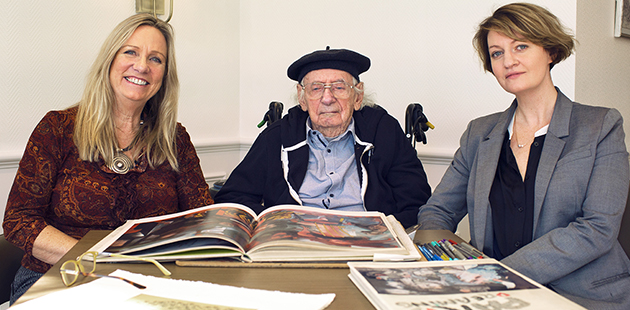 Known as one of the Australia’s greatest painters, artist, Charles Blackman OBE has passed away. The Charles Blackman Foundation has released the following statement:
Known as one of the Australia’s greatest painters, artist, Charles Blackman OBE has passed away. The Charles Blackman Foundation has released the following statement:
It is with deep sadness that we announce this morning that our beloved father Charles Blackman OBE passed away just one week after his 90th birthday celebrations.
Charles Blackman is regarded as one of the most important figurative painters in Australia. Best known for his Schoolgirl and Alice in Wonderland series, Blackman’s artistic practice spanned painting, drawing, sculpture and tapestry, using his multidisciplinary approach to explore the female psyche, poetry, music and aesthetic philosophies.
Blackman’s work is held in all major public collections in Australia and internationally including the Metropolitan Museum of Art in New York, and the Tate Gallery in London. He was the recipient of many prizes and distinctions including a major touring retrospective in 1993 and was appointed an Officer of the British Empire (OBE) for services to Australian art in 1977.
A portrait of Charles Blackman by Jon Molvig won the Archibald Prize in 1966 and in August 2010, the Blackman Hotel opened in St Kilda Road, Melbourne that feature 670 fine prints by Charles Blackman. Ursula Dubosarsky’s novel The Golden Day was directly inspired by Blackman’s 1954 painting Floating Schoolgirl, which is in the collection of the National Gallery of Australia, Canberra.
The family recently celebrated Charles’ 90th birthday and he had been working with the family on an extensive celebratory exhibition titled The Evening is the Morning, that will now be a tribute to his life and career. His daughters, Bertie and Christabel, have been newly appointed co-managers of the Charles Blackman Foundation.
“The most profound conversations I have ever had with my father have been without words,” said Bertie Blackman. “I sat next to him and listened to the scratches of his pen as he carefully pressed an imprint of his secret language. The line. The line that draws him. The line that can never hide.”
“It is an extraordinary thing to watch and be a part of… like the ink is the thread that holds us together in that moment. In his fading light he did little else than draw. Ghostly static schoolgirl shapes… boats and cats and windows. He was like the Cheshire Cat. Grinning and enthralling you in one moment… and in the next… invisible but always there.”
“It has been a privilege and an honour to have the opportunity to wander through the windows and chasms of such an intricate and incredibly deep feeling mind. I walk with him and hold his hand as he wanders… and we hope that you too will come with us… upside down and downside up! … down the rabbit hole.”
Born on August 12, 1928 in Sydney, Australia, Charles Blackman was largely self-taught having left school at the age of thirteen and became an illustrator at the Sun newspaper before moving to Melbourne in the mid-1940s. Following the move, Blackman befriended fellow artists Joy Hester, John Perceval, and Laurence Hope, and gained the support of the art critic and patron John Reed.
In 1959, Blackman collaborated with a number of figurative artists, including John Brack, Arthur Boyd, and Robert Dickerson to create The Antipodeans group, which railed against Australian artists adopting American Abstract Expressionism and other non-figurative styles. His work is associated with dreamlike images tinged with mystery and foreboding. He went on to receive the Order of the British Empire in 1977.
In 1960 he and his family lived in London after Blackman won a Helena Rubinstein travelling scholarship, settling in Sydney upon his return five and a half years later. In 1970 he moved to Paris, when awarded the atelier studio in the Cité des Artes. He lived there for a year at the same time as John Coburn, and subsequently returned often, as Paris was an eternal source of inspiration.
After 27 years of marriage, Barbara Patterson Blackman and Charles Blackman divorced in 1978. He married the young artist Genevieve de Couvreur divorced after 8 years of marriage, and in 1989, he married his third wife, Victoria Bower, from whom he was separated. He has six children, Auguste, Christabel, Barnaby, Beatrice, Felix and Axiom, most of them artists and musicians in their own right.
A celebratory tribute to the artist, the Charles Blackman Foundation will present its inaugural exhibition, The Evening is the Morning, at the Harvey Galleries from Saturday 22 September 2018.
Image: Christabel, Charles and Bertie Blackman (supplied)
